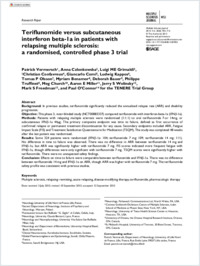Teriflunomide versus subcutaneous interferon beta-1a in patients with relapsing multiple sclerosis: a randomised, controlled phase 3 trial
- Vermersch, Patrick Neurology, University of Lille Nord de France, Lille, France
- Czlonkowska, Anna Second Department of Neurology, Institute of Psychiatry and Neurology, Warsaw, Poland
- Grimaldi, Luigi ME Fondazione Istituto San Raffaele “G. Giglio” di Cefalù, Cefalù, Italy
- Confavreux, Christian Neurology, University Claude Bernard, Lyon, France
- Comi, Giancarlo Neurology and Neurophysiology, University Vita-Salute San Raffaele, Milan, Italy
- Kappos, Ludwig Neurology and Department of Biomedicine, University Hospital Basel, Basel, Switzerland
- Olsson, Tomas P Clinical Neuroscience, Karolinska Institute, Stockholm, Sweden
- Benamor, Myriam Global Pharmacovigilance and Epidemiology, Sanofi, Chilly Mazarin, France
- Bauer, Deborah Statistics, Sanofi, Bridgewater, NJ, USA
- Truffinet, Philippe Global Pharmacovigilance and Epidemiology, Sanofi, Chilly Mazarin, France
- Church, Meg Neurology, Fishawack Communications Ltd, North Wales, PA, USA
- Miller, Aaron E Corinne Goldsmith Dickinson Centre of Multiple Sclerosis, Icahn School of Medicine at Mount Sinai, New York, NY, USA
- Wolinsky, Jerry S Neurology, University of Texas Health Science Center at Houston, Houston, TX, USA
- Freedman, Mark S University of Ottawa, the Ottawa Hospital Research Institute, Ottawa, ON, Canada
- O’Connor, Paul St Michael’s Hospital, University of Toronto, 30 Bond Street, Toronto, ON, Canada
- 2013-10-14
Published in:
- Multiple Sclerosis Journal. - SAGE Publications. - 2013, vol. 20, no. 6, p. 705-716
English
Background: In previous studies, teriflunomide significantly reduced the annualised relapse rate (ARR) and disability progression. Objective: This phase 3, rater-blinded study (NCT00883337) compared teriflunomide with interferon-beta-1a (IFNβ-1a). Methods: Patients with relapsing multiple sclerosis were randomised (1:1:1) to oral teriflunomide 7-or 14mg, or subcutaneous IFNβ-1a 44µg. The primary composite endpoint was time to failure, defined as first occurrence of confirmed relapse or permanent treatment discontinuation for any cause. Secondary endpoints included ARR, Fatigue Impact Scale (FIS) and Treatment Satisfaction Questionnaire for Medication (TSQM). The study was completed 48 weeks after the last patient was randomised. Results: Some 324 patients were randomised (IFNβ-1a: 104; teriflunomide 7 mg: 109; teriflunomide 14 mg: 111). No difference in time to failure was observed. There was no difference in ARR between teriflunomide 14 mg and IFNβ-1a, but ARR was significantly higher with teriflunomide 7 mg. FIS scores indicated more frequent fatigue with IFNβ-1a, though differences were only significant with teriflunomide 7 mg. TSQM scores were significantly higher with teriflunomide. There were no unexpected safety findings. Conclusion: Effects on time to failure were comparable between teriflunomide and IFNβ-1a. There was no difference between teriflunomide 14 mg and IFNβ-1a on ARR, though ARR was higher with teriflunomide 7 mg. The teriflunomide safety profile was consistent with previous studies.
- Language
-
- English
- Open access status
- hybrid
- Identifiers
-
- DOI 10.1177/1352458513507821
- ISSN 1352-4585
- Persistent URL
- https://sonar.ch/global/documents/201616
Statistics
Document views: 31
File downloads:
- fulltext.pdf: 0
